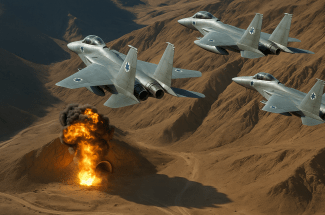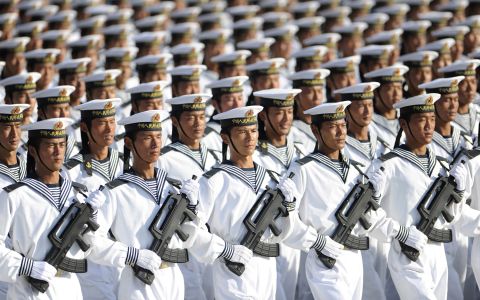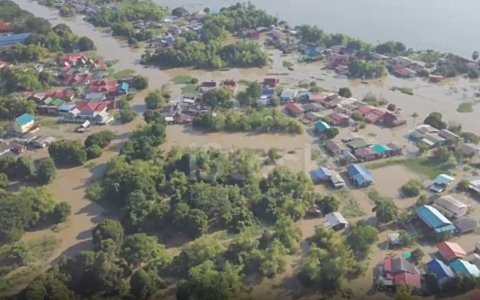Iran’s War on Israel 16: The Imminent Pre-Emptive Strike on Iran

Summary
The international standoff over Iran’s nuclear programme has reached a tipping point. With diplomatic efforts exhausted and uranium enrichment accelerating, Israel appears poised to launch a pre-emptive strike on Iranian nuclear facilities. Intelligence reports confirm Iran’s stockpile could soon yield multiple nuclear weapons, while cooperation with Russia and China continues to shield Tehran from effective sanctions. Trump’s diplomacy has stalled, widening a rift with Israeli Prime Minister Netanyahu, who increasingly views military action as a matter of national survival. The United States, meanwhile, has begun withdrawing personnel from key embassies, while the UK warns of regional military escalation. Global Forecaster assesses that a major escalation in the Iran-Israel conflict into a full-blown regional war is now imminent. What is very clear is that a decisive IDF strike will be needed to prevent Iran’s nuclear breakout and broader regional destabilisation.
Introduction
We have been warning that a strike on Iran's nuclear facilities was inevitable, as outlined in Iran’s War on Israel 11; Imminent Nuclear Breakout and the IDF and American Response. In the ongoing series tracking the inevitable path toward an Israeli and/or U.S. strike, we view that the moment has now arrived. With a probability of 95%, such a strike is likely to occur within the coming days or weeks. The consequences will be profound, triggering a potentially extended and escalating conflict across the Gulf region that could bring China into a kinetic war. Consequently, this situation demands everyone's attention and awareness.
1.0 - Trump Is Following Chamberlain’s Path to War
Trump’s fruitless negotiations with Tehran have reached a dead end. While he has pushed for a new nuclear deal, Iran has been accelerating its military build-up, advancing rapidly towards nuclear breakout. Despite issuing a two-month deadline backed by vague threats of military action, that window has now closed. All U.S. proposals have reportedly been rejected, and Tehran shows no signs of slowing its programme.
Iran’s strategy is clear: stall negotiations with Washington while manipulating European governments into delaying any meaningful consequences. Even if a new agreement were reached, history shows it would likely be meaningless. Tehran has repeatedly violated both the Obama-era nuclear deal and its obligations under the Nuclear Non-Proliferation Treaty. In truth, Iran has shown no intention of ever abandoning its nuclear ambitions.
The consequences of U.S. inaction extend well beyond the Middle East. Moscow and Beijing will closely watch any perceived weakness in Washington’s response. If the U.S.—even under its most assertive leadership in years—fails to enforce its own red lines, it will signal a dangerous erosion of deterrence. Ultimately, deterrence rests on a credible display of political will—something Trump, despite his rhetoric, has yet to demonstrate convincingly.
2.0 - Iran’s Nuclear Threat Grows as Diplomacy Falters
A new report from the International Atomic Energy Agency (IAEA), drawing heavily on intelligence provided by Israel’s Mossad, confirms that Iran has conducted undeclared nuclear implosion tests—an essential step in developing atomic weapons. Although these tests occurred nearly two decades ago, experts warn that the technical knowledge and infrastructure remain intact, positioning Iran for a potential nuclear breakout as early as 2025.
The report details Iran’s testing of explosive neutron initiators, the development of uranium conversion equipment, and the retention of highly contaminated nuclear materials—clear indicators of a covert and systematic nuclear weapons programme. Furthermore, Iran has actively obstructed international oversight by sanitising key sites and providing misleading information to the IAEA.
These revelations come at a critical moment. Negotiations between Iran and the United States are on the brink of collapse, and Israeli officials have issued stark warnings that military action may soon follow. The urgency is growing for international intervention, potentially including a referral to the United Nations Security Council.
In parallel, Iran is accelerating its nuclear activities. The IAEA confirms that Tehran is enriching uranium to 60 percent purity—dangerously close to the 90 percent required for weapons-grade material. At its current pace, Iran is producing enough fissile material to build one nuclear bomb per month and now holds a stockpile sufficient for up to ten weapons. Experts estimate that, once a political decision is made, Iran could enrich its uranium to weapons-grade levels in as little as two weeks. The UN nuclear watchdog’s Board of Governors has found that Iran violated its non-proliferation agreement for the first time in two decades.
In a strongly worded statement, the board demanded that Tehran provide answers “without delay” regarding a long-running investigation into uranium traces found at several undeclared sites—locations Iran has not acknowledged as part of its nuclear program. In response to the ruling, the Islamic Republic announced it would establish a new enrichment facility at a “secure location” and would “significantly” expand its production of enriched uranium.
Behrouz Kamalvandi, spokesman for Iran’s Atomic Energy Organisation, stated: “We are replacing all of these first-generation machines with sixth-generation advanced machines” at the Fordow uranium enrichment plant, located south of Tehran. He added that the upgrade would result in a “significant increase” in enriched uranium production. This amounts to a declaration of war by Iran.
3.0 - Trump Holds Firm on Non-Enrichment as Iran Approaches Nuclear Breakout
Trump reaffirmed that the United States maintains its position that Iran must not be permitted to enrich uranium. His remarks followed a 2 June Axios report revealing that a recent U.S. nuclear proposal would allow Iran to enrich uranium up to three percent on its own soil for a limited, negotiated period alongside establishing a regional nuclear consortium. However, unnamed diplomatic sources told Reuters that Iran intends to reject the proposal, calling it a "non-starter" for failing to ease U.S. restrictions. The deal is thought to include a provision requiring Iran to permanently suspend enrichment activities once the temporary allowance expires.
4.0 - Iran Advances Toward Nuclear Breakout Amid Stalled Negotiations
Meanwhile, as outlined above, Iran has increased its stockpile of 60 percent enriched uranium by 133.8 kilograms (equivalent to approximately 3.2 significant quantities) since February 2025, according to a classified report from the IAEA. This stockpile could be further enriched to weapons-grade and used to produce up to ten nuclear warheads. The pace of enrichment since the 12 April resumption of U.S.-Iran talks has accelerated, confirming that Iran is making the final jump in its nuclear breakout. A separate 31 May IAEA report noted, with a massive degree of understatement, that Iran’s cooperation has been “less than satisfactory” across key areas of nuclear transparency.
5.0 - 12 June Deadline Has Passed
Trump and Israeli Prime Minister Benjamin Netanyahu held a phone call on 9 June amid increasing signs that Iran intends to reject the U.S. offer. Trump stated that both nations are set to meet again on 12 June—a date that reportedly marks the U.S. deadline for Iran to agree to a deal. Netanyahu also convened his security cabinet to discuss military options. Iran’s Supreme National Security Council responded with a stark warning: any Israeli strike on Iran’s nuclear infrastructure would result in retaliatory attacks on Israel’s "covert nuclear facilities."
6.0 - Netanyahu Pressures Trump, Considers Unilateral Strike
Trump has reportedly urged Netanyahu not to conduct unilateral strikes while talks remain ongoing, emphasising that a peaceful resolution could "save a lot of lives." However, Israeli officials have warned the U.S. that even a new deal would not guarantee restraint, particularly if it fails to eliminate Iran’s enriched uranium stockpile. Intelligence reports suggest Israel is actively preparing for such a strike, based on intercepted communications, movement of munitions, and recent military exercises.
7.0 - A Strategic Schism Emerges
The growing rift between Trump and Netanyahu reflects a fundamental divergence in strategy. Netanyahu—facing what he views as an existential threat—has adopted the role of a modern-day Churchill, determined to prevent Iran from acquiring nuclear weapons at all costs. He reportedly sees the nuclear issue not just in political terms but as a matter of national survival, especially given Israel’s status as a "one-bomb state."
Israel’s military lacks B-2 stealth bombers and deep-penetration GBU-72 munitions, meaning the IDF may be forced to consider using low-yield tactical nuclear weapons against hardened Iranian targets. Such a decision would cross a significant threshold and could provoke broader conflict, including a possible response from China.
8.0 - The Deepening Iran-Russia-China Strategic Alliance Linked to Illegal Oil Trade & Chemical Provisions
Iran continues to strengthen its strategic ties with Russia and China. Moscow has publicly backed Iran’s right to enrich uranium and has signalled support for further trilateral negotiations. On 29 May, Iran, China, and Russia’s UN representatives met to coordinate positions. Russian envoy Mikhail Ulyanov later proposed another deputy-level summit to advance shared objectives. Persistent rumours suggest Moscow may have transferred nuclear miniaturisation technology to Iran—though unconfirmed, such a move would dramatically escalate the threat landscape.
Recent activity in the Persian Gulf reveals ongoing illicit cooperation between Iran and China. On 20 May, a U.S.-sanctioned tanker sent out a false distress signal in the Strait of Hormuz before likely conducting a ship-to-ship transfer of Iranian oil—allowing China to bypass Western sanctions and maintain a covert economic alliance with Tehran.
Meanwhile, Iran is continuing to draw upon China to replenish its solid-fuel ballistic missile stockpile after Israel destroyed Iranian production sites in October 2024. Sources told the Wall Street Journal on 5 June that Iran has ordered thousands of tonnes of ammonium perchlorate from China in recent months. This compound comprises about 70 percent of the propellant in solid-fuel missiles. This follows earlier transfers of sodium perchlorate, which can be converted into ammonium perchlorate. These shipments could support the production of up to 800 ballistic missiles, some of which could be distributed to Iranian proxies such as the Houthis and Russian forces.
9.0 - Netanyahu's Narrowing Options
With time running out and his international support waning, Netanyahu may see a pre-emptive strike as his only viable path. Rejected by Trump and facing condemnation from European allies over Israel’s military actions in Gaza, Netanyahu’s posture has hardened. Israeli defence sources suggest a unilateral operation could come soon and would be overwhelming in scale.
The split between diplomacy and pre-emption has become a defining challenge of this moment. Whether Netanyahu proceeds without U.S. backing could reshape the balance of power in the Middle East and possibly trigger a wider, more dangerous conflict with global ramifications. A sudden Israeli strike on Iran may prove diplomatically costly, but in Netanyahu’s eyes, it may be the only path to avoid Israel’s annihilation. Increasingly, he appears to view such an operation as essential for national survival.
10.0 - Secretary of State Marco Rubio & the UK Government Send Warning Signals
The United States has authorised the voluntary departure of nonessential personnel from its embassy in Baghdad, as well as from diplomatic missions in Bahrain and Kuwait, amid rising tensions with Iran. Secretary of Defence Pete Hegseth has extended the same option to military dependents across the Middle East. Although no specific threat has been publicly identified, the move reflects growing concern over the stalled U.S.-Iran nuclear negotiations and fears that Israel may launch a strike on Iran’s nuclear facilities. Iranian officials have warned that the U.S. would be held accountable if such an attack occurs. President Donald Trump, while reiterating his opposition to military action, acknowledged that talks have stalled and expressed growing concern about reaching a diplomatic resolution.
Meanwhile, the UK Maritime Trade Operations agency has issued a warning about the heightened risk of military escalation in the region. It cautioned that rising tensions could threaten vital shipping routes and advised vessels to exercise heightened vigilance while navigating the Gulf, the Gulf of Oman, and the Strait of Hormuz—strategic waterways adjacent to Iran.
11.0 - Prognosis – An IDF Strike Is Imminent

We believe that an Israeli strike on Iran’s nuclear facilities is now imminent, escalating the conflict to a full-blown regional war. If the IDF is forced to act alone, there is a risk that it may resort to using ground-penetrating tactical nuclear weapons against Iran’s deeply buried installations. However, if US B-2 bombers join the operation, such extreme measures may be avoided.
In either scenario, Iran is likely to view the United States as complicit, potentially triggering a broader regional conflict and a retaliatory war that could close the Strait of Hormuz, disrupting global energy supplies and increasing the risk of Chinese intervention. In our evaluation, it would be better for America to join the IDF in a show of strength in the preemptive strike, rather than being drawn in subsequently, which would appear a show of weakness to the Axis of Autocracy. Either way, Iran will eventually, as the strike sequence escalates, seek to block the Gulf in an act of retribution.
As such, Global Forecaster assesses that the world is now teetering on a dangerous precipice. Preventing Iran from acquiring nuclear weapons is an urgent strategic imperative. It now requires decisive and overwhelming military action by the IDF and the United States if there is to be any hope of preserving what little remains of peace in the Middle East—and of being taken seriously by Xi and Putin.
Key Predictions:
- An Israeli military strike on Iranian nuclear facilities is likely within days with a 95% probability.
- If the United States does not participate in the strike, Israel may resort to low-yield tactical nuclear weapons to destroy deep underground targets, crossing a significant strategic threshold.
- Iran will interpret any Israeli strike as U.S.-backed, triggering a retaliatory campaign across the Gulf and possibly closing the Strait of Hormuz, disrupting global energy flows.
- China may be drawn into the conflict, particularly if regional maritime trade or energy routes are affected.
- A wider regional war is highly likely, involving Iran’s proxies (such as the Houthis and Hezbollah) and potentially forcing U.S. military escalation.
- Strategic deterrence is eroding globally, with Moscow and Beijing closely watching Western resolve. Failure to act decisively may embolden adversaries in Ukraine and the Indo-Pacific.
- The Iran-Russia-China axis will deepen, with increasing collaboration on missile technology, illicit oil trading, and possible nuclear miniaturisation support from Moscow to Tehran.
- Netanyahu’s decision to strike may be unilateral and overwhelming in scale, reflecting both political desperation and a belief that time has run out.
- Diplomatic channels are effectively exhausted with no realistic path to a renewed or enforceable nuclear agreement.
- Western credibility is on the line. Without swift, overwhelming military intervention, the global order risks permanent destabilisation.



















Comments
Gold
Hi, David
Thanks for the updates, which has translated into gold, oil up, USD down, May I ask, with your playbook of Yields rising, USD down and equities down. Will this drag Gold equities down, GDX ? or will they hold up with Physical Gold. Thanks boyd
I remain super bullish of…
I remain super bullish of precsious metals and the minners.....what do you think of the layout of the Murrinations?